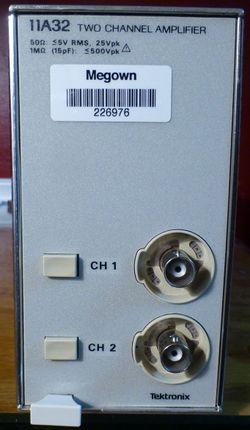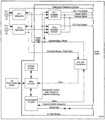11A32: Difference between revisions
No edit summary |
No edit summary |
||
| Line 22: | Line 22: | ||
The fine steps between the deflection ranges are calibrated in 1% increments. | The fine steps between the deflection ranges are calibrated in 1% increments. | ||
The 11A32 | The 11A32 and the [[11A34]] use exactly the same firmware. | ||
Each of the 11A32’s two channels has its own M377 amplifier. | |||
and the | The display outputs of the two amplifiers are hard wired in parallel and drive the mainframe’s 50 Ω input impedance. | ||
The same is true of the trigger outputs of | The same is true of the trigger outputs of the two amplifiers. | ||
The version of the M377 used in the 11A32 has 100 Ω output impedance so that two of them in parallel create a source impedance of 50 Ω. | |||
Each M377 amplifier's nominal common-mode output voltage is zero whether enabled or not. | |||
When not enabled each M377 differential output is exactly zero by design. | |||
This fact is used during calibration by the plugin’s firmware to determine the mainframe’s imbalance and compensate for it during normal operation. | |||
See the block diagram below. | See the block diagram below. | ||
Revision as of 16:27, 29 December 2022
The Tektronix 11A32 is a 400 MHz dual-channel amplifier plug-in for 11000-series scopes. Each of the attenuator modules contains an M474 buffer amplifier. Each of the attenuator modules feeds an M377 amplifier IC. The output signals of the two M377s combine at the output of the 11A32. The fine steps between the deflection ranges are calibrated in 1% increments.
The 11A32 and the 11A34 use exactly the same firmware.
Each of the 11A32’s two channels has its own M377 amplifier. The display outputs of the two amplifiers are hard wired in parallel and drive the mainframe’s 50 Ω input impedance. The same is true of the trigger outputs of the two amplifiers. The version of the M377 used in the 11A32 has 100 Ω output impedance so that two of them in parallel create a source impedance of 50 Ω.
Each M377 amplifier's nominal common-mode output voltage is zero whether enabled or not.
When not enabled each M377 differential output is exactly zero by design. This fact is used during calibration by the plugin’s firmware to determine the mainframe’s imbalance and compensate for it during normal operation. See the block diagram below.
Key Specifications
| Bandwidth | DC to 400 MHz plus 100 MHz and 20 MHz BWL filters |
|---|---|
| Rise time | 875 ps in 1 GHz mainframe such as the 11402, 11402A, 11403, 11403A, DSA601A, or DSA602A |
| Deflection | 1 mV to 10 V per division in 1% calibrated steps |
| Input impedance | 50 Ω or 1 MΩ |
| Features |
|
Internals
The 11A32 and 11A34 were originally intended to use Intel 8052 microcontrollers. However, during development, the firmware swelled beyond that chip's 8192-byte maximum on-chip ROM size. Doug Haines found an alternate supplier of 8051-compatible chips (OKI Semiconductor) that offered a 16Kbyte on-chip ROM, and that's what the plug-ins wound up with. The finished code size wound up at about 14 KB.
The 11A32 also contains a DS1120 NVRAM and an ACVS sample and hold module.
Links
Pictures
-
-
-
Block diagram
-
11A32 Main Board Schematic
-
11A32 Main Interface
-
left side internal
-
right side internal
Custom ICs used in the 11A32
| Page | Model | Part nos | Description | Designers | Used in |
|---|---|---|---|---|---|
| M377 | M377 | 165-2129-03 • 165-2089-06 • 155-2089-05 | amplifier | John Addis | 11A16 • 11A32 • 11A33 • 11A34 • 11A52 • 2245 • 2245A • 2247 • 2247A • 2252 • TDS410 • TDS420 • TDS460 • TDS520D • TDS540D • TDS580D • TDS680C • TDS684C • TDS714L • TDS724D • TDS754D • TDS784D |
| M474 | M474 | amplifier | John Addis • Ivan John Cousins | 11A32 • 11A34 |





